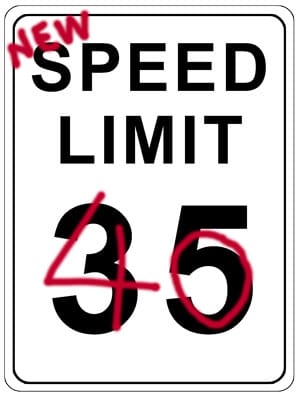The Psychology of Speed Limits

by Terri Wiebold
The science and psychology of speed limits is a study that spans decades. It is comprised of multitudes of speed studies, reports, measurements, accident reviews, surveys, and a lot of documentation. Much of the research referred to in this article is provided by the Colorado Department of Transportation Safety and Engineering Branch, as well as the Douglas County Public Works Traffic Engineering Division.
How are speed limits established?
Under Colorado law, speed limits are based on prima facie limits – those that “on the face of it” appear to be safe and prudent under normal conditions.
Existing posted speed limits have been established by state and local entities and are based on the assumption that the careful and competent actions of a responsible person should be considered legal, and that most drivers are reasonable people who will drive at the speed which is suitable for the existing conditions.
What is realistic?
An appropriate or realistic speed limit is one at which the maximum number of vehicles are traveling at about the same speed, and one that will be voluntarily obeyed by the majority. The speed which 85% of the traffic is not exceeding (referred to as the 85th percentile speed) is widely accepted as being a realistic speed limit.
Although the 85th percentile speed is used as the major guideline in setting speed limits, other factors such as land use, sight distance, pedestrian activity, accident history, etc., are considered in the decision making process. An engineering study of these factors must be conducted in order to change a posted speed limit.
Will a change in the speed limit put drivers and pedestrians at an increased risk?
There are many misconceptions about a driver’s speed in relation to the posted speed limit. Some of the most common include:
Reducing the speed limit will automatically slow the speed of traffic, while raising the speed limit will automatically increase the speed of traffic. Of the many studies conducted over the years in various parts of the country, most have consistently shown that a driver’s speed is influenced more by the appearance of the roadway and the prevailing traffic conditions than it is by the posted speed limit.
Most motorists drive five to 10 miles per hour more than the posted speed limit anyway, so lower limits should be established to account for this condition. Lower speed limits are potentially more dangerous because some drivers will obey the lower posted speed, while others will view it as unreasonable and simply ignore it. This disrupts the uniform flow of traffic and increases the potential for lane changes, passing, and braking – all behaviors associated with an increased risk of accidents.
Increasing the speed limit will make it more difficult for drivers to merge into moving traffic. When traffic is traveling at different speeds, traffic is more dispersed and the number of breaks in traffic is reduced, making it harder for drivers to pull out of side streets and merge into the flow of moving traffic. When the majority of vehicles travel at relatively consistent speeds, the grouping of vehicles creates clear opportunities (gaps in traffic) for motorists pulling out from cross streets. When vehicles are traveling at vastly different speeds, it makes it more difficult for drivers and pedestrians to judge the speed of approaching vehicles.
What impact will a speed limit increase have on drivers?
Most before-and-after speed studies indicate that there are no significant changes in vehicle speeds after speed limits are changed. Accident studies also do not typically show any significant change in accident rates after speed limits are increased or decreased.
Why establish speed limits?
Although some may argue speed limits are strictly a way for government entities to generate revenue, the rational for regulation of speed is based on the fact that unreasonable speed can cause property damage and/or personal injury. Additionally, speed laws provide a basis for punishing the unsafe behavior of drivers who put others at unnecessary risk.
Establishing safe and reasonable speed limits is an important, necessary, and sometimes challenging responsibility of any government agency. For speed limit information specific to Douglas County, contact Douglas County Traffic Engineering at 303-660-7490 or traffic@douglas.co.us. Also, read specifics about the recent changes to speed limits in Castle Pines North in the upcoming December issue of The Connection.